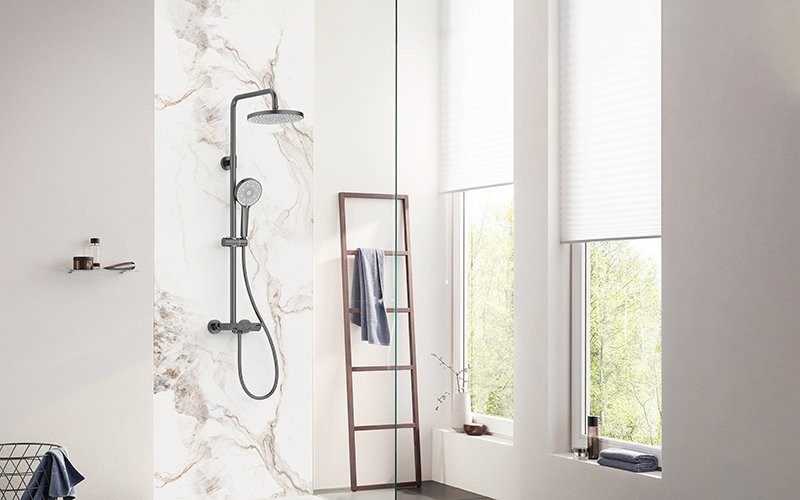Table of Content
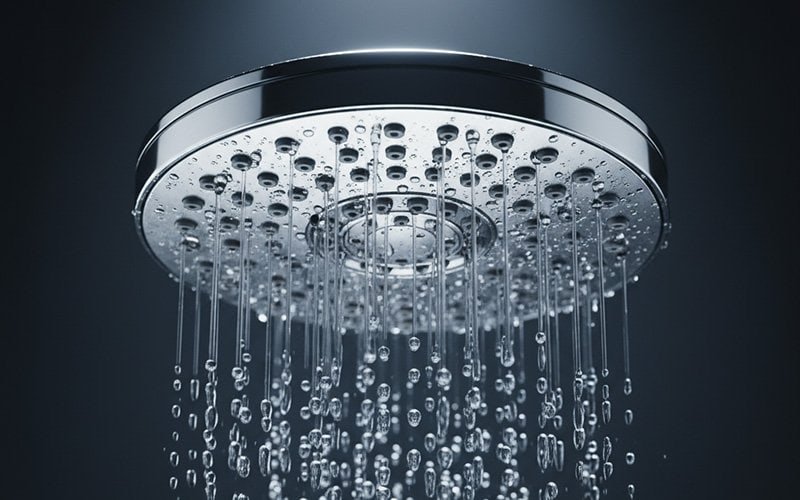
Choosing a shower head is a bigger deal than you might think. It affects your daily routine, your utility bills, and even your environmental impact.
This guide cuts through the noise. You’ll learn the essential terms, understand the rules, and see the different types of shower heads available. We’ll cover everything from basic installation to the latest smart technology. By the end, you’ll have the confidence to pick the right shower head for your home.
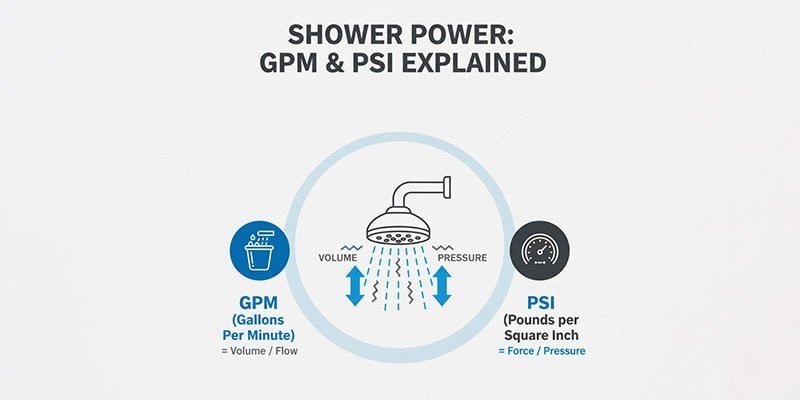
Understanding the Basics: GPM and PSI
Before you get into features, you need to know two key terms: GPM and PSI. Understanding how they work together is the first step to choosing a shower head you’ll be happy with.
What is GPM (Gallons Per Minute)?
GPM stands for Gallons Per Minute. It measures the volume of water your shower head uses every minute.1 This number, also called the “flow rate,” directly impacts how much water you use and how much you pay to heat it.
Modern shower heads typically have flow rates like 1.5, 1.8, 2.0, or 2.5 GPM.2 For comparison, shower heads made before the 1990s often used 3.5 GPM or more, with some older models using a staggering 5 to 8 GPM.
What is PSI (Pounds per Square Inch)?
While GPM is about volume, PSI (Pounds per Square Inch) measures the force of the water coming through your pipes. It’s the “push” that makes your shower feel strong or weak.
For a good shower, your home needs at least 40 PSI. The ideal range is between 40 and 80 PSI, with 60 PSI being perfect for most homes. If your home’s water pressure is consistently low, a new shower head alone won’t fix the problem.
GPM vs. Perceived Pressure
It’s easy to mix up GPM and PSI since they both affect how your shower feels. But they are different. A high GPM shower head won’t fix low PSI; it will just use more water, weakly.
You might worry that a lower GPM means a “wimpy shower.” That used to be true, but not anymore. Modern low-flow shower heads are engineered to feel powerful even while using less water.
If you have low water pressure (low PSI) throughout your house, the issue is with your plumbing system. Common causes include:
- Clogged Pipes: Mineral deposits and rust can build up over time, especially in older pipes, restricting water flow.
- Partially Closed Valves: Your main water valve or water meter valve might not be fully open, which limits pressure to your whole house.
- Failing Pressure Regulator: If the pressure regulator where your water line enters the house fails, it can cause low pressure.
- Hidden Leaks: A small leak anywhere in your system can cause a noticeable drop in pressure.
To fix low PSI, you need to address these underlying plumbing problems. A new shower head can’t fix a system-wide issue.
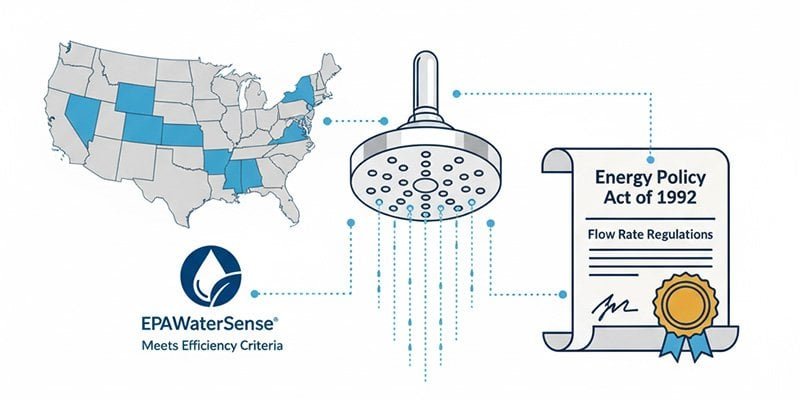
The Legal Landscape: Regulations & Certifications
The shower head you can buy is shaped by laws designed to conserve water. Knowing these rules is key to making sure your choice is compliant and efficient.
Federal Mandates: The Energy Policy Act of 1992
The Energy Policy Act of 1992 set the foundation for modern shower head rules. This federal law established a nationwide maximum flow rate of 2.5 GPM for all new shower heads sold in the United States. This law applies to manufacturers and retailers, not homeowners, but it dictates what’s available for you to buy.
State & Local Restrictions: Going Even Lower
While 2.5 GPM is the federal limit, many states and cities have set even stricter rules. This means a shower head that’s legal in one state might not be in yours. Always check your local regulations before buying.
Here are some of the key regulations:
| State/Region | Maximum GPM Allowed |
|---|---|
| California | 1.8 GPM |
| New York State | 1.8 GPM |
| New York City | 2.0 GPM |
| Colorado | 2.0 GPM |
| Washington | 1.8 GPM |
| Hawaii | 1.8 GPM |
| Oregon | 1.8 GPM |
| West Hollywood, CA | 1.5 GPM |
| All other US States | 2.5 GPM (Federal Standard) |
EPA WaterSense Program: The Gold Standard for Efficiency & Performance
To help you find products that are both efficient and high-performing, the U.S. Environmental Protection Agency (EPA) created the WaterSense program in 2006.19 This voluntary program gives a special label to products that meet strict standards.
The WaterSense label is a guarantee that you won’t sacrifice comfort for conservation. To earn it, a shower head must be independently tested and certified to:
- Use 2.0 GPM or less, making it at least 20% more efficient than the federal standard.
- Meet high performance standards for spray force and water coverage.
- Provide a consistent flow across a wide range of home water pressures.
Look for the WaterSense label to avoid “greenwashing” and ensure you’re getting a product that is genuinely efficient and performs well.
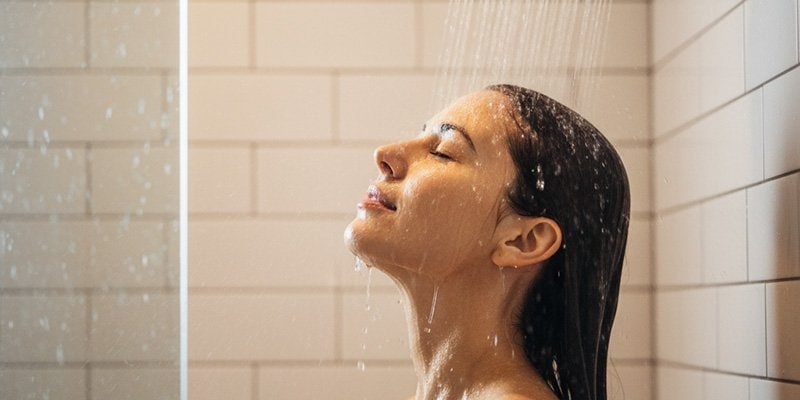
Shower Experience: Beyond Just Flow Rate
Ultimately, you want a shower head that delivers a great shower. The good news is that modern engineering means you no longer have to choose between a powerful shower and a water-saving one.
The “Wimpy Shower” Myth Debunked
You might think that less water means a weaker shower, but that’s no longer the case. Today’s best water-saving shower heads use smart design to make the spray feel powerful while using less water.
They do this with technologies like:
- High-Pressure Nozzles: Smaller, specially shaped openings make the water exit with more force. It’s like putting your thumb over a garden hose—the same amount of water feels much stronger.
- Aeration: Some shower heads mix air into the water stream. This creates larger, lighter droplets that make the spray feel fuller, even though it’s using less water.
- Laminar Flow: This technology creates smooth, individual streams of water that provide great coverage with less splashing.
- Brand Technologies: Companies like Waterpik have developed special systems, such as PowerPulse Massage, which delivers a pulsating spray that is clinically shown to provide twice the massage force of other shower heads.
Key Factors for a Great Shower Experience
A great shower is personal. When you choose a shower head, think about:
- Spray Patterns: Many shower heads offer multiple settings. You can often switch between a wide spray, a powerful massage jet, a gentle mist, or even a water-saving “pause” mode.
- Coverage: How wide do you want the spray to be? Some people like a narrow, powerful stream, while others prefer wide, “shoulder-to-shoulder” coverage. Good coverage is especially important if you use a shower bench.
- Rinsing Ability: If you have long or thick hair, you need a shower head with enough force to rinse out shampoo and conditioner effectively. Handheld shower heads are great for this because you can direct the spray exactly where you need it.

Types of Shower Heads for Every Need
The market has a shower head for every need and preference. The right choice for you depends on what you value most, whether it’s simplicity, luxury, or practicality.
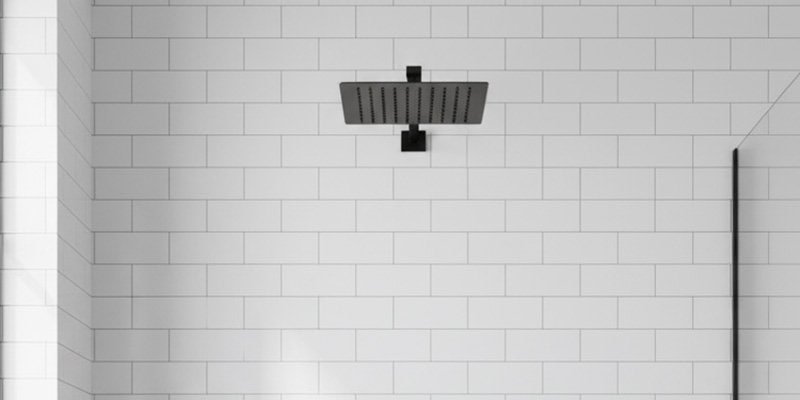
Fixed Shower Heads
This is the traditional shower head mounted to the wall or ceiling. While it stays in one place, you can usually swivel it to adjust the angle.
- Description: This is the most traditional and common type of shower head, mounted directly to the shower arm extending from the wall or ceiling. While its position is fixed, it typically features a swivel ball joint that allows you to adjust the angle of the spray.
- Best For: Those who value simplicity, affordability, and a straightforward, reliable shower experience. Fixed heads are often an excellent choice for maintaining consistent water flow, even in homes with lower-than-average water pressure.
- Pros: Generally easy to install, require minimal maintenance, and are available in the widest range of styles and price points.
- Cons: Their primary drawback is a lack of flexibility. It can be difficult to rinse specific areas of the body, and they are not helpful for tasks like washing pets or cleaning the shower enclosure itself.
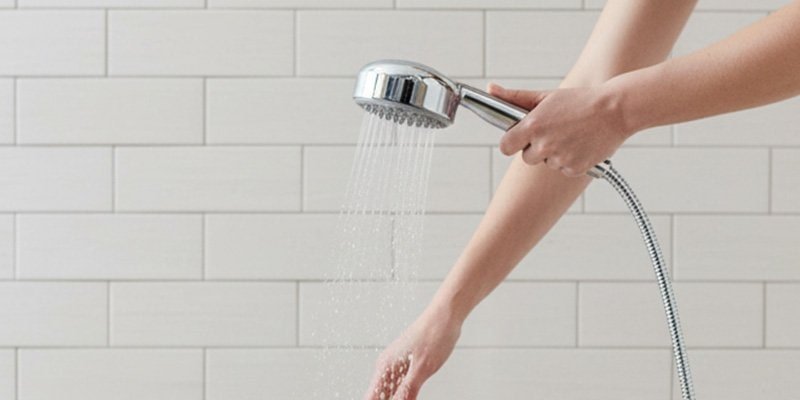
Handheld Shower Heads
A handheld shower head is a wand connected by a flexible hose. You can leave it in its bracket or hold it to direct the spray.
- Description: A handheld shower head is a detachable wand connected to the water supply by a long, flexible hose (typically 60 to 72 inches). It sits in a wall-mounted bracket or on a slide bar, allowing it to function like a fixed head, but can be removed for targeted use.
- Best For: Unmatched versatility. They are the ideal solution for families with young children, pet owners, and individuals with limited mobility who may need to shower while seated.
- Pros:
- Accessibility: Greatly simplifies the process of bathing children, pets, or assisting the elderly by bringing the water exactly where it’s needed.
- Targeted Rinsing: Perfect for thoroughly rinsing shampoo from long, thick hair or directing a massaging spray onto sore muscles.
- Easy Cleaning: Makes cleaning the shower walls and tub a much faster and easier task.
- Cons: Can sometimes have a slightly lower perceived pressure compared to a similarly rated fixed head due to the path the water travels. They also tend to be more expensive.
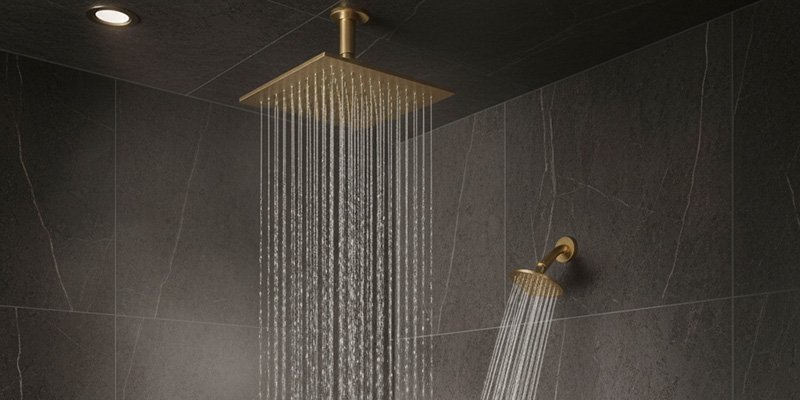
Dual/Combination Shower Heads
This system gives you both a fixed head and a handheld wand. A diverter valve lets you use one at a time or both together for a full-body spray.
- Description: For those who refuse to compromise, a dual or combination system offers the best of both worlds. These setups typically include both a fixed shower head (often a large rain model) and a separate handheld unit, connected by a diverter valve. This valve allows you to use one head at a time or both simultaneously for a truly enveloping experience.
- Best For: Anyone seeking the ultimate in customization and a spa-like experience at home. They are perfect for households where different members have different showering preferences.
- Pros: Maximum flexibility, allowing you to enjoy the immersive spray of a fixed head and the practical convenience of a handheld wand in one system.
- Cons: These systems are more expensive, their installation is more complex, and running both heads simultaneously will split the available water pressure, which may result in a weaker flow from each.
Rain Shower Heads
These large-diameter shower heads are mounted overhead to mimic the feeling of standing in the rain. They focus on relaxation and coverage rather than high pressure.
- Description: Characterized by their large diameter (often 6 to 12 inches or even larger), rain shower heads are designed to deliver a gentle, broad stream of water from directly overhead, mimicking the sensation of standing in a warm, summer rainfall. They can be mounted from the ceiling or high on the wall using an extension arm.
- Best For: Creating a luxurious, calming, and spa-like atmosphere. The focus is on relaxation and total body coverage rather than high-pressure force.
- Pros: Provides exceptional, even water coverage for a soothing and therapeutic feel. Their sleek, modern appearance can serve as a stunning centerpiece in a bathroom design.
- Cons: By design, they often have a lower perceived water pressure. They are typically more expensive and can require more complex plumbing modifications for installation, especially for true ceiling-mounted models.
High-Pressure Specific Designs
These shower heads are built to maximize the force of the water spray. They use special nozzles and internal chambers to make the water exit with greater velocity.
- Description: These are shower heads engineered with the primary goal of maximizing the force of the water spray. They use technologies like optimized nozzles and internal pressure-boosting chambers to increase the water’s exit velocity, creating a powerful and invigorating shower.
- Best For: Individuals who crave a strong, blasting shower to wake them up or wash away the day. They are also an excellent solution for homes with low-to-moderate water pressure (PSI), as they can make a weak flow feel much stronger.
Low-Flow Specific Designs
- Description: Also known as water-saving or high-efficiency shower heads, these models are designed with water conservation as their core principle, featuring GPM ratings of 2.0 or less. They employ the advanced technologies discussed earlier (like aeration and specialized nozzles) to deliver a satisfying shower experience while minimizing water consumption.
- Best For: Environmentally conscious consumers, anyone looking to reduce their monthly utility bills, and residents living in areas with strict GPM regulations, such as California or Colorado. A classic example is the Speakman Hotel Low-Flow Shower Head, which provides a robust and enjoyable shower at just 1.75 GPM.
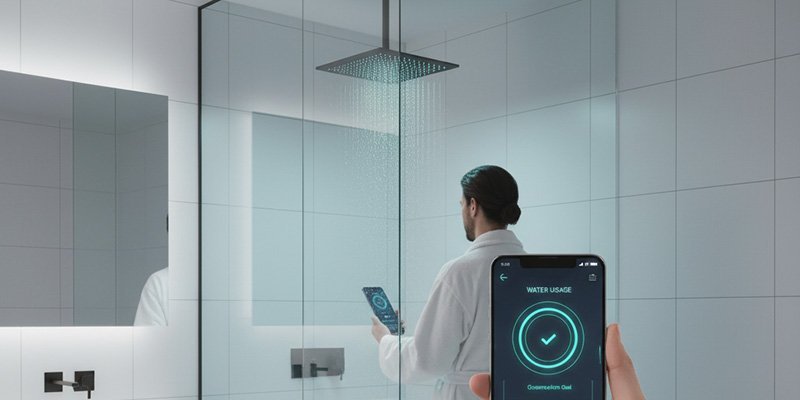
Advanced & Smart Technologies: The Future of Your Shower
Beyond the traditional categories, the shower head is evolving. Technology is transforming this simple fixture into a smart, responsive, and health-conscious device. The future of the shower is not just about how the water feels, but also about how intelligently it is used and how pure it is when it reaches your skin.
Smart Shower Heads
Smart shower heads go beyond just being efficient; they actively help you save water by responding to what you do.
- Active Water Saving: These heads are designed to stop “behavioral waste”—the water that goes down the drain when you’re not using it. For example, the Oasense Reva uses sensors to tell when you step away to lather up. It then automatically reduces the flow to a trickle and returns to full power when you step back, which can save up to 50% of your shower water.
- Personalization & Tracking: Some smart shower heads connect to your phone. The Hai smart shower head uses Bluetooth to sync with an app, letting you set water-saving goals and track your usage. It also has an LED light that tells you when the water is warm or when you’re close to your time limit, making it easier to build good habits.
Filtration Systems: Enhancing Water Quality
Water quality is just as important as pressure and flow. Shower head filters remove impurities from your water before they reach your body.
- Better Hair and Skin: Your tap water contains chlorine, which can dry out your skin and hair. A good filter removes much of this chlorine, leaving your skin softer and your hair healthier and shinier.
- Prevent Clogs: If you have hard water, minerals can clog your shower head’s nozzles. A filter traps these minerals, which keeps your shower head working well and helps it last longer.
- Antimicrobial Features: Some shower heads even have nozzles made with antimicrobial materials that resist the growth of mold and mildew.
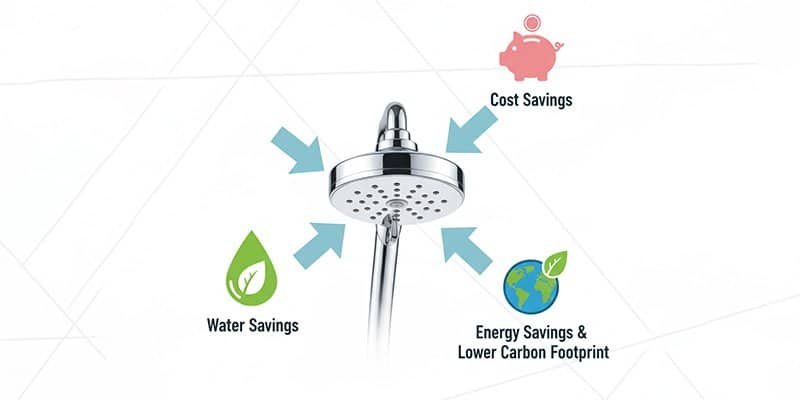
Environmental Impact & Cost Savings
Choosing a water-efficient shower head is one of the easiest ways to make your home more eco-friendly. It’s a small change that saves water and energy, which lowers your carbon footprint and your utility bills.
Significant Water Conservation
Your daily shower uses a lot of water. In fact, showers account for about 17% of all the water used inside your home. That adds up to nearly 40 gallons of water per day for the average family.
Nationally, that’s about 1.2 trillion gallons of water used for showering each year in the U.S. alone.
The good news is that you can make a big difference. By switching to a WaterSense-labeled shower head, you could save around 2,700 gallons of water per year. For a family of three, switching from a 2.5 GPM to a 1.75 GPM head could save over 1,000 gallons every month.
Energy Conservation & Reduced Carbon Footprint
When you save water, you also save energy. A lot of energy is used to pump and treat water, but even more is used to heat it for your shower.
By installing a low-flow shower head, you can save over 330 kilowatt-hours (kWh) of electricity per year. That’s enough to power your house for about 11 days. This reduction in energy use means a smaller carbon footprint, which helps protect the environment.
Direct Cost Savings
All this conservation saves you money. An efficient shower head pays for itself through lower utility bills.
You’ll see savings on both your water bill and your energy bill. Since you’re using less water, you’re also heating less water, which cuts down on your gas or electricity costs.
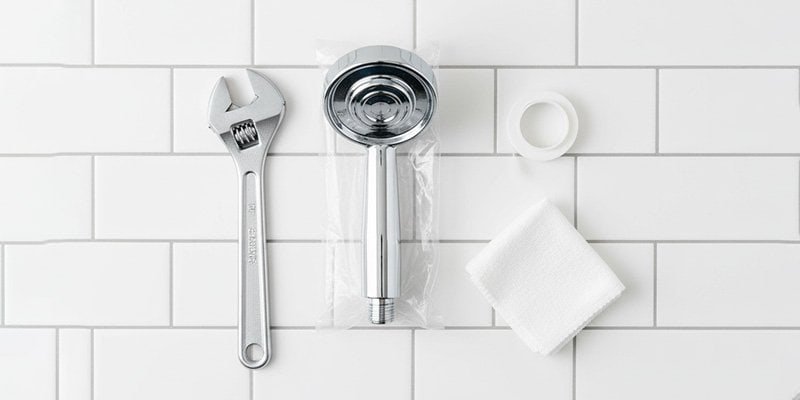
Practical Advice: Installation, Maintenance & Troubleshooting
Changing your shower head is an easy DIY project. With a few tools and some simple steps, you can install a new one and keep it working perfectly.
Measuring Your Current Flow Rate (The Bucket Test)
Want to know your current shower head’s GPM? The “bucket test” is a quick and easy way to find out.
- Get Ready: Make sure no other water is running in your house.
- The Test: You’ll need a bucket with a 1-gallon mark and a stopwatch. Turn your shower on to your normal pressure. Place the bucket under the stream and start the timer.
- Calculate: Stop the timer as soon as the water hits the 1-gallon mark. Use this formula: GPM=60÷(time in seconds). For example, if it took 30 seconds, your GPM is 60÷30=2.0.
Checking Your Home’s Water Pressure (PSI)
If you think your home has low water pressure, you can test it yourself. Buy a water pressure gauge from a hardware store and screw it onto an outdoor hose spigot.
Turn the faucet on all the way to get an instant PSI reading. If it’s below 40 PSI, you likely have a plumbing issue that a new shower head won’t fix.
Installation: DIY vs. Pro
Replacing a shower head is a simple DIY job that you can usually do in under 30 minutes.65
- DIY Steps:
-
- Remove the Old Head: Unscrew the old head by turning it counterclockwise. If it’s stuck, use pliers to hold the shower arm steady and a wrench to loosen the head. Wrap a rag around the pipe to protect the finish.
- Clean the Threads: Use an old toothbrush to clean any old tape or gunk off the shower arm’s threads.
- Apply New Tape: Wrap new thread seal tape (plumber’s tape) around the threads 2-3 times in a clockwise direction.
- Install the New Head: Screw the new head on by hand until it’s snug.
- Check for Leaks: Turn on the water and check for drips. If you see any, tighten the connection a little more until they stop.
- When to Call a Plumber: Call a plumber for more complex jobs, like replacing the shower arm or installing a ceiling-mounted rain shower.
Maintenance for Optimal Performance
Regular cleaning will keep your shower head working well.
- Clean Clogs with Vinegar: Mineral buildup can clog your shower head’s nozzles. To clean them, fill a plastic bag with white vinegar and secure it over the shower head with a rubber band. Let it soak for a few hours, then remove the bag and run hot water to flush it out.
- Replace Filters: If your shower head has a filter, follow the manufacturer’s instructions for replacing it, usually about every six months.
The Flow Restrictor: To Remove or Not to Remove?
Most modern shower heads have a small plastic piece inside called a flow restrictor, which limits the GPM to meet federal standards. You might be tempted to remove it for more power.
- Is it Legal? The federal law applies to manufacturers, not you. So, it’s generally legal to modify your own shower head.
- Should You Do It? Before you do, consider the downsides. Removing it might violate local codes, especially in places like California.61 It will also likely void your product’s warranty and will increase your water and energy bills.
- For Landlords: If you’re a landlord, tenants removing flow restrictors can drive up your utility costs. Tamper-proof systems like “The Water Scrooge” can be installed behind the wall to prevent this.

Making Your Choice: A Personalized Approach
There is no single “best” shower head. The right one for you depends on your home, your local laws, your lifestyle, and what you want from your shower.
Key Factors to Consider
Use this checklist to narrow down your options:
- Local Regulations: What is the maximum GPM allowed where you live? This is your starting point.
- Your Water Pressure (PSI): If your pressure is low, look for a “high-pressure” shower head.
- Conservation Goals: If saving water is your top priority, choose a WaterSense model with a low GPM.
- Your Shower Preference: Do you want a powerful blast or a gentle rain-like shower?
- Your Needs:
- Kids & Pets: A handheld shower head is incredibly useful.
- Mobility Issues: A handheld head is safer and more convenient for showering while seated.
- Long Hair: You’ll want a head with a strong, focused spray for easy rinsing.
- Material and Durability: Solid metal shower heads, like brass or stainless steel, will last longer than plastic ones.
- Style: Choose a finish that matches your bathroom’s other fixtures.
- Budget: Balance the upfront cost with long-term savings on your utility bills.
Here’s a quick summary to help you decide:
| Shower Head Type | Best For You If… | Key Benefit | Key Consideration |
|---|---|---|---|
| Fixed | You want something simple, reliable, and affordable. | Low maintenance and consistent flow. | Not very flexible for targeted rinsing. |
| Handheld | You have kids, pets, or mobility issues. | Extremely versatile and great for cleaning. | May feel less powerful than a fixed head. |
| Dual/Combination | You want maximum flexibility and a spa feel. | The best of both fixed and handheld. | Higher cost; splits pressure when both are used. |
| Rain | You want a relaxing, luxurious shower. | Soothing, full-body coverage. | Lower perceived pressure; may need plumbing changes. |
| High-Pressure | You love a powerful spray or have low home PSI. | Invigorating feel and great for rinsing. | Uses more water and energy than low-flow models. |
| Low-Flow | You’re eco-conscious or live in a regulated area. | Saves water, energy, and money. | Relies on good design to feel powerful. |
Adjustable Settings for Flexibility
If you’re not sure what you want, or if different people in your home have different preferences, get a shower head with adjustable spray settings. That way, you can switch between a powerful jet, a gentle spray, or anything in between.
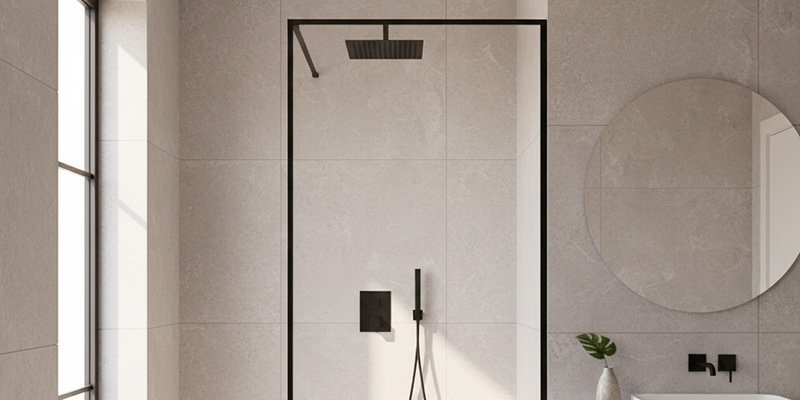
Conclusion: Shower Smarter, Not Harder
Choosing the right shower head starts with understanding your home’s water pressure (PSI) and flow rate (GPM). From there, you can explore the different types and find one that fits your needs and local rules.
Most importantly, you don’t have to sacrifice a great shower to save water. Modern shower heads are designed to feel great while being efficient. By making a smart choice, you can improve your daily routine, save money on your utility bills, and help the environment.
FAQs
Related Posts








